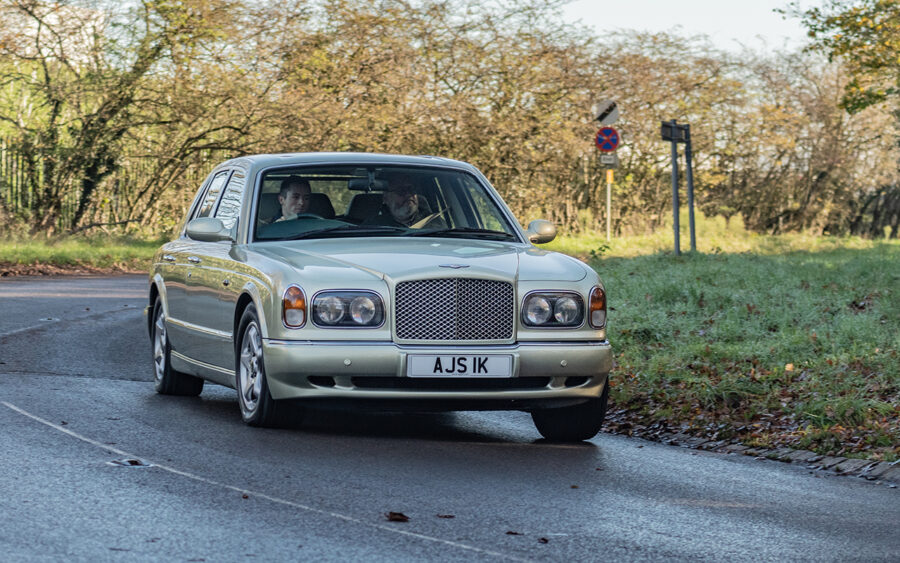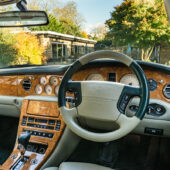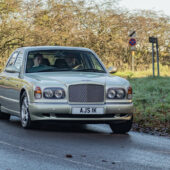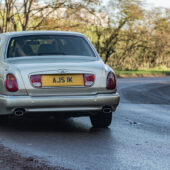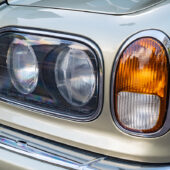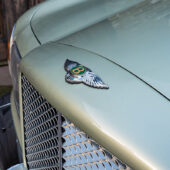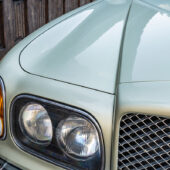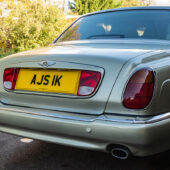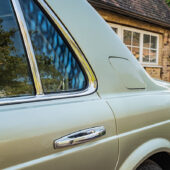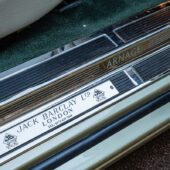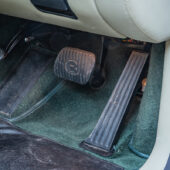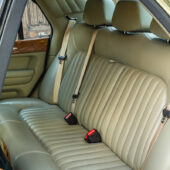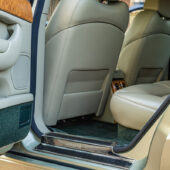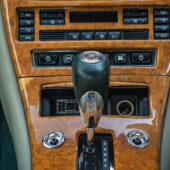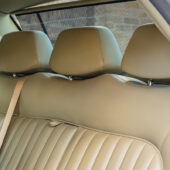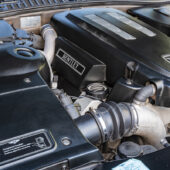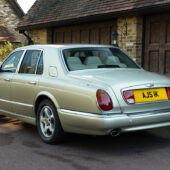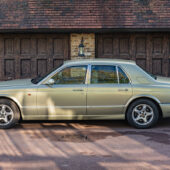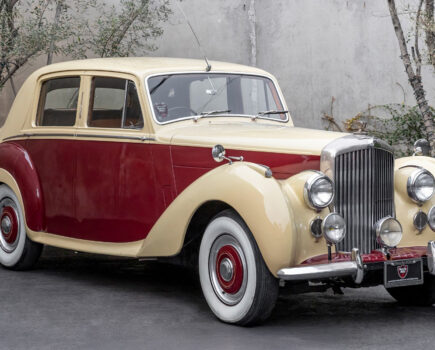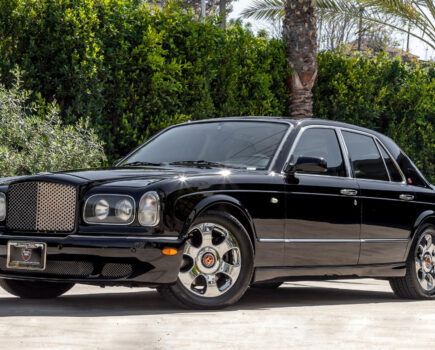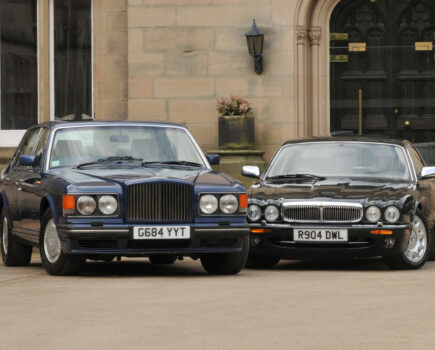The original BMW-engined Arnage offers a delicate balance of features that sets it apart as something special
Words: Aaron McKay Images: Gregory Evans
When Rolls-Royce introduced its L-series V8 in 1959, few could have predicted it would go on to enjoy a career spanning six decades, powering a wide array of ultra-luxurious saloons and high-performance behemoths. And thanks to the company’s adoption of turbocharging for Bentleys of the 1980s and beyond, the classic V8 managed to remain competitive (in terms of power and performance) well into old age. Once thoughts turned to replacing the long-running SZ-series cars with an all-new generation of Rolls-Royce and Bentley saloons, however, the L-series was effectively on death row thanks to one major issue: emissions.
Unsurprisingly, after forty years of service, it was decided that developing a new engine would be more effective than trying to educate the old pushrod V8 in the ways of a world it simply didn’t understand. The problem was that Rolls Royce and Bentley owner Vickers didn’t have the money to pursue either route as well as developing the new car so desperately needed to succeed the ageing SZ series that had begun with the Silver Spirit and Bentley Mulsanne of 1980. A proprietary engine shortlist was made, including a modular V12 from Ford and General Motors’ latest Northstar V8, but the serious contenders were from Mercedes-Benz and BMW. A majority of management and some champions in the engineering departments settled it: BMW engines would motivate a new generation of Rolls-Royce and Bentley models.
I know, you don’t have to like it. But here’s why you might. Introduced in June 1998, two months after its V12-powered Rolls-Royce Silver Seraph sister car, the Bentley Arnage featured a new type of 4.4-litre V8 from BMW, with Cosworth overtones. Leaving the BMW factory, this M62-code engine retained the headline features like double-overhead cams, 32 valves and even fracture-split connecting rods, but was fitted with lower compression pistons in preparation for Cosworth’s work.
Also owned by Vickers at the time, Cosworth Engineering added two low-inertia turbochargers cleverly sited in a casting close to the exhaust manifold, for sharper response. The result wasn’t a spectacular swelling of outputs, with 350bhp and 413lb.ft. representing around a 25% gain on what you’d find in a normally-aspirated BMW 740i (and it’s actually less than the previous Turbo RT’s output), but there were hidden advantages that we’ll discover later. It was an impressive technical specification, certainly a sporting one, as well as allowing Bentley to refer to it as the return of the 4½ Litre.
Anthony Kearsley, owner of the 1999 Arnage you see here, remembers it well. From behind a sales desk at Jack Barclays in the 90s, he saw the last-of-the-line of SZ models practically fly through the door – in both senses of the word – and the turbulent Silver Seraph and Arnage era that followed. An appreciation of the old school is clear – there’s a Brooklands R Mulliner, Bentley T2, plus more of the pre-1990s in his collection – but Anthony remains a stout defender of the original Arnage: “It’s amazing that some people change the badges to red, just to hide the engine. It’s really a dream partnership, BMW and Cosworth, so why would you hide it?”
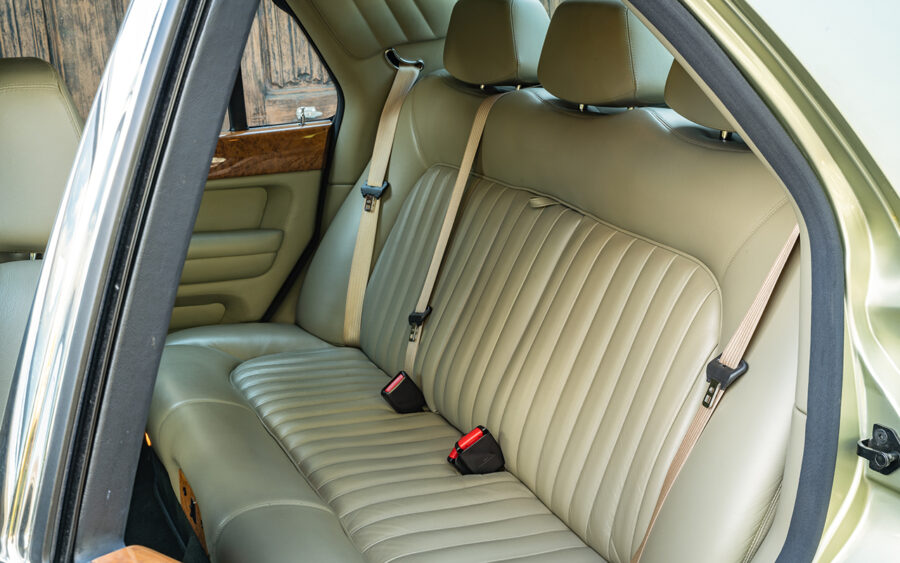
This particular Arnage features a bespoke bench seat, made up and fitted by in-house Mulliner Park Ward
For him, however, it’s not just the engineering behind the Arnage. This particular car is special to Anthony because he’s the one who managed the order back in 1998, and it was quite an unusual one. The call came in out the blue, directed from aboard a yacht. The car had to have parking sensors, blinds, umbrellas and a bit more stretching-out room in the back. To this day, Anthony won’t divulge his customer’s name (a Jack Barclay policy that survives past retirement), but suffice to say that money was not a discussion point and the car was promptly paid for in full. The final specification was agreed and the build began, with Anthony visiting to check on its progress more than a dozen times.
One feature in particular took a little extra time and, of course, money: a bench seat in the rear, replacing the individual seats normally separated by a centre console. Absolutely this could be done, Sir, and so the car was built with a temporary seat before the bespoke item was made up and fitted by in-house Mulliner Park Ward. Specially formed, including a central headrest, curiously it still retained the recline function, operated via a switch mounted centrally in front of the seat bottom. Both this and the seat itself look completely normal at first, so you might not realise it was never a standard option; but the reality is that Type Approval had to be obtained before it could be delivered.
The Arnage stayed with that original owner for just a matter of weeks, serving its purpose as stylish ferry to the Royal Ascot races before being sent back to Jack Barclay to be sold on commission. This was a difficult time for the original Arnage, and this specially prepared example sat waiting in the showroom for a while. Eventually, however, it found an owner and went off to the south of France, but not before securing a lasting impression on Anthony. For the time being, the trail went cold and he didn’t see the car again until 2016, when he spotted it for sale at marque specialist, Hanwells of London.
Anthony decided he had to have it, but he was too late – the Bentley was already being prepared for its next owner. An offer with profit to the new owner didn’t work either. This wasn’t nearly as disheartening as when it came up for sale again in 2018, this time in the Bentley Drivers Club magazine, and halfway through negotiations the sale fell through. Anthony began to believe it was never to be, that he wasn’t supposed to have this car.
Then just a matter of months later, in 2019, while in Esher for a meeting, Anthony decided to pop in to the nearby Barons classic vehicles auction… and there it was: an early Arnage, in Iridium and with a single rear bench. The registration number confirmed it – this was the car, and this time he wasn’t too late. Although he feared a final battle of bids to win, Anthony was relieved when there was no dramatic showdown. After such a long wait for the car that had captured his imagination even before it was built, the Arnage was finally his.
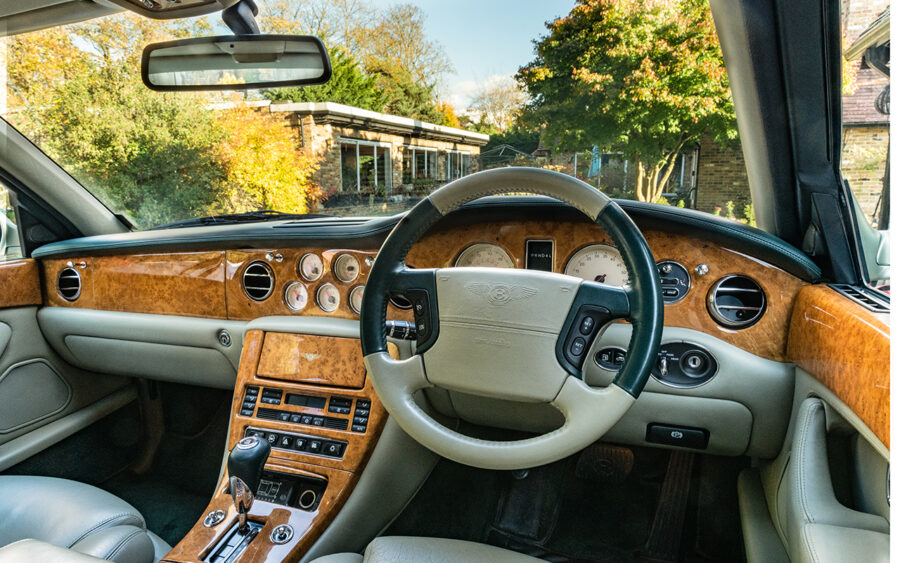
During Anthony’s early ownership of the Bentley, he got to enjoy his first long trip at the wheel, heading to the south of France for a holiday. More recently, however, the car had to get used to being locked up for longer periods than it might prefer, thanks to the Covid-19 crisis and the restrictions it has brought. On the day of our photo shoot, however, carried out when the UK isn’t in a major lockdown, Anthony turns the key and the car starts effortlessly and immediately, whooshing its pulleys powerfully in that trademark Rolls-Royce and Bentley fashion. A nice touch, Anthony tells me, is a reserve battery that ensures the car will always start – a bit of modern convenience already showing.
Just sitting in the Arnage is a soothing experience, and so it is when you get the car moving. I reckon I’d get 30mpg just as easily as Anthony did on the autoroutes, not just because it’ll sit under 2000rpm at 70mph but because it is truly enjoyable to feather the controls and access the easy, gliding torque behind the throttle. It rides beautifully too, filtering out low-speed bumps with ease but remaining supremely dignified even across the most awkwardly of staggered mini roundabouts, demonstrating excellent spring and damper control. It feels even better at speed, providing just enough float to give it that wonderful feeling of taking long strides into the distance.
Press a little more towards the carpet (because, of course, you can’t help it) and you’ll hear the muffled throb of a V8 at 3000rpm, with the speed escalating rather alarmingly. It’s a quick car, there’s no doubt about it, and there’s so little sensation of speed that it does indeed feel ‘Bentley quick’. And yet it’s not how the twin-turbo V8 fires this two-tonne car down the road which impresses most; if it were, then by all means take a Red Label. It’s all the bits in between.
Big, comfortable and powerful cars can be really frustrating to drive fast. It’s almost always an exercise of early on the brakes, careful on the steering and even more careful on the throttle before you and the car can take a deep breath again and ‘floor it’ down the next straight. The BMW-engined Arnage is not like this. It’s not frustrating and it’s not a series of dangerous exercises; it’s actually enjoyable. It feels ‘together’, particularly at the front where the steering is surprisingly weighty and provides crisp control; even on cold, damp roads you can begin to feel what the car is doing, where the grip is. The pedals that at one moment allow soft stops and smooth getaways also have a helpful degree of precision when worked harder. It hustles with satisfying ease, never feeling uncomfortable. And even approaching its impressive limits, when the 2302kg is more noticeable, it’s not threatening thanks largely to a 50:50 weight distribution. Whether you’re going fast or at a cruise, this is a driver’s car, albeit with maximum refinement.
The engineer that lives inside every keen driver will also appreciate the Arnage’s set-up, beyond that fine BMW-Cosworth V8. Developed with the Mayflower Corporation, the structure is 65% stiffer than the SZ series and uses double wishbones all round. The springs are 40% stiffer than on the Silver Seraph, there are uprated anti-roll bars, and the dampers are more aggressive too. It’s also a nice touch that the Sport button on the gearshift automatically primes the dampers in a stiffer setting. That’s an adaptive five-speed gearbox by the way, not the four-speed seen in the later Red Label cars.
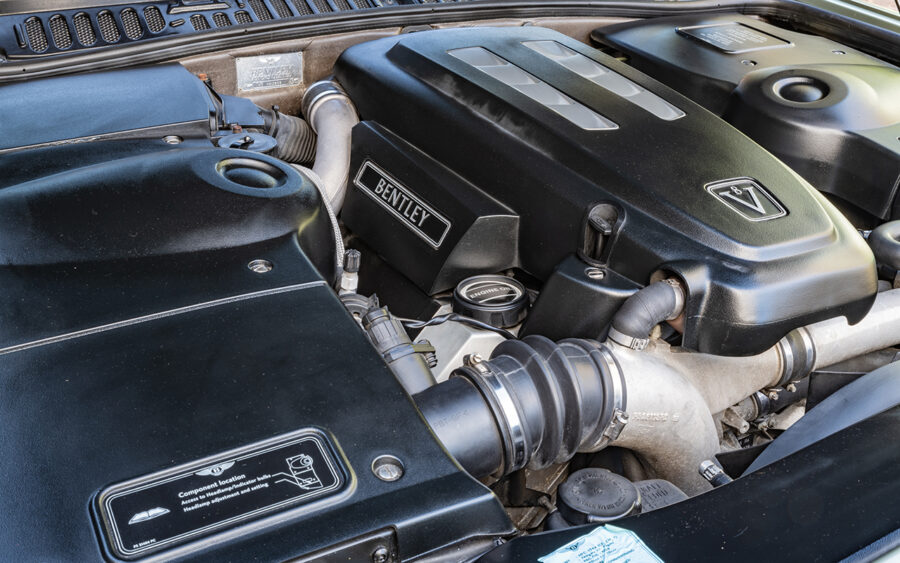
I have to talk about the Red Label for a bit though, as it resulted in improvements to the Arnage’s chassis and packaging when introduced in 2000. There was a stronger floorpan and transmission tunnel, while a new cast-alloy brace reinforced the engine bay, and minor revisions were made to the suspension and traction control. This was to help contain the all-British 6.75-litre V8 that was being brought back to life (via generous funding from Bentley’s latest owner, Volkswagen), ultimately replacing the 4.4-litre BMW-Cosworth unit in what would now be known as the Arnage Green Label for the rest of its short career. For just one year, buyers could order a 4½-litre Bentley with these upgrades, including the extra two inches of legroom and an inch of extra headroom afforded by new front seat backs and a lower floor.
Regardless, there is every amenity for your comfort in the original Arnage. Seat adjustments, warm or cool air or both, arm rests and, of course, that deafening quiet once you close the door. This car even has the optional rear sunblind and parking sensors neatly illustrated on a little panel ahead of the leather and chrome gear selector. All of this stuff – yes, even the BMW switchgear – is absorbed into the general opulence of the cabin, though. Masses of Light English Oak here, complemented by Savannah leather with Spruce leather dash-top and carpets. The dials are a bit old world with their cream backings, but even so the set of five in the centre look suitably Bentley. The seats are a little on the firm side, but you still sink into this interior. Naturally the carpeting is as plush as every other material around, while even the headlining is leather.
It’s a tightly packaged car, not having an appreciably greater footprint than the previous SZ generation. That it’s actually 5mm narrower probably does make the special rear bench particularly welcome. But as far as design goes, I’d say there is a great deal to appreciate about the Arnage. It sits confidently on the road, with a 59mm wider track – at 1608mm front and rear, in fact, it’s wider than any contemporary luxury saloon you care to mention. But only a little, and all the way around the car there’s a careful balance of self-assured elegance.
The highest impact features are the aluminium-mesh grille at the front and weighty C-pillar that continues its Bentley S-series evocation into an elevated boot. Yet thanks to this measured restraint, the rest of the car’s details tie in neatly. Aerodynamic bumpers reduce a bit of the visual bulk front and rear, tasteful bits of chrome meet tailored creases in the bodywork, while dark accents in the wheels and black headlamp fixtures highlight the bits that mean business. Smoked tail lamps presumably serve as a cool dismissal of those you overtake.
So, is a Bentley without its six-and-three-quarter V8 also lacking its defining character – the very essence of what makes it a Bentley? Some purists might think so. But Rolls-Royce Motors’ decision to seek BMW propulsion for its dynamic new duo of 1998 (a twin-turbo V8 in the case of the Arnage, a normally-aspirated V12 for the Silver Seraph) was entirely understandable, given the lack of budget at that time and the pressure brought by future emissions constraints. The original 4½-litre Arnage surely deserves its place in Bentley’s glorious history. If Anthony weren’t so attached to his, I reckon I might have pinched it…

